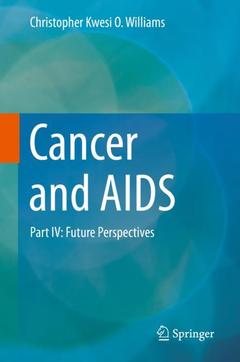Description
Cancer and AIDS , 1st ed. 2019
Part IV: Future Perspectives
Author: Williams Christopher Kwesi O.
Language: English
Subjects for Cancer and AIDS :
Keywords
Approximative price 105.49 €
In Print (Delivery period: 15 days).
Add to cart45 p. · 15.5x23.5 cm · Hardback
Description
/li>Contents
/li>Comment
/li>
Part IV: Future Perspectives
Chapter 10 – Strategies for progress
Abstract
Section 10.1.0: The role of international partnership in the development of global health systems
Section 10.1.1: Models of humanitarian global outreach in health care
Section 10.1.2: The concept of “convergence” and the future of health care research
Section 10.1.3.0: The concept of global health
Section 10.1.3.1: Models of global health partnership in cancer control
Section 10.1.3.2: The tiered resource stratification framework of the Breast Health Global Initiative (BHGI) Network
Section 10.1.3.3: ASCO’s resource-stratified guidelines for the management of invasive cervical cancer
Section 10.1.3.4: NCCN framework for resource stratification for invasive cervical cancer
Section 10.1.3.5: Resource-stratified approaches in the primary prevention of cervical cancer
Section 10.1.3.5.1 ASCO resource-stratified guideline for the primary prevention of cervical cancer
Section 10.1.3.6: Resource-stratified approaches in the secondary prevention of cervical cancer
Section 10.1.3.4.1: Selected Global Health Activities for promoting cancer control/Health Volunteers Overseas (HVO)
Section 10.1.3.4.2 Global Curriculum and Mentoring Program
Section 10.1.3.4.3: Global Curriculum and Mentoring Program/International Development and Education AwardSection 10.1.3.4.4: Proposal for recognizing global oncology as an academic field
Section 10.2: Overcoming barriers to progress in the control of cancer and retroviral diseases, including HIV/AIDS
Section 10.2.1: Prioritizing strategies for universal health coverage
Section 10.2.1.1: mHealth Strategies for Universal Health CoverageSection 10.2.1.2: Community Health Insurance Coverage as a strategy for Universal Health Care
Section 10.2.1.3: Innovation in provider training as a strategy in UHC
Section 10.2.2: The role of politics in attainment of Universal Health Coverage
Section 10.2.3: The role of science and engineering in human welfare
Section 10.2.3.1: The role of science
Section 10.2.3.1.1: Science advocacy
Section 10.2.3.1.2: Science education in low- and middle-income countries
Section 10.2.3.1.3 Examples of the transforming effect of science in LMICs
Section 10.2.3.1.3.1 Impact of science on the emergence of South Korea
Section 10.2.3.1.3.2: Impact of science on Middle-Eastern cooperation
Section 10.2.3.1.3.3: Impact of the US-Cuba scientific diplomacy
Section 10.2.3.1.3.4: Boosting science in Singapore
Section 10.2.3.1.3.5: India boosts its ambitious space program
Section 10.2.3.2: Transforming the practice of engineering to meet global health needs
Section 10.2.3.3 Models in innovation with potentials for cancer and HIV/AIDS control in LMICs
Section 10.2.3.3.1: Affordable, weather durable x-ray machine
Section 10.2.3.3.2: Affordable cancer immunotherapy in Cuba
Section 10.2.3.3.3: The smart village for rural electrification
Section 10.2.3.3.4: HIV/AIDS control in China
Section 10.3: The future of control of cancer and retroviral diseases
Page 1055: Section 10.3.1: From the National Cancer Act to the 21st Century Cures Act
Page 1059: Section 10.3.2: Advances in lung cancer prevention
Page 1062: Section 10.3.3: Ending the HIV/AIDS pandemic
Page 1063: Section 10.3.4: Finding a cure for AIDS – a possible convergence of cancer and HIV/AIDS research
IndexA description of the clinical features of cancer in resource-poor settings with dramatic illustrations based on author's own observations
Emphasis of the interactions between chronic infections, including retroviruses (HIV/AIDS, HTLV-I) and the cancer burden of the low and middle-income world
A chapter describes the unique features of childhood hematological cancers in Africa, and the role of lifestyle and environmental factors in pathogenesis of various cancers, including breast cancer




